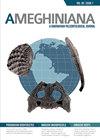晚古生代的被动动态步行者
IF 1.5
4区 地球科学
Q3 PALEONTOLOGY
引用次数: 1
摘要
摘要研究了两条上二叠纪的苏科龙属(ichnogenus Sukhonopus)的足迹,被认为是pareiasaurian。较长的轨道包括15.5个机车周期。对其维数的统计分析表明,步态是一种接近慢步的横向序列行走。这一结论通过对两条轨迹的尺寸与在Deltavjatia异角龙骨骼上测量的髋臼与骨臼长度之比的比较得到了额外的支持。由于下肢四足动物典型的四肢伸展姿势,根据被动动态行走的原则,只能通过身体左右摇摆来进行步伐。制作了一个自然大小的Sukhonopus生产者模型。这个模型再现了被动动态摇摆的步伐,通过绳子将其向前拉,同时将其从一侧推到另一侧来手动驱动。该模型证明了翼龙的被动动态摇摆速度是可行的,但需要对后肢和前肢进行功能区分。前者更适合于推进,而后者则更有效地产生推动摇摆运动所需的横向力。据推测,这种行走机制与古代四肢神经和肌肉供应的缺乏有关。古生代的其他四足动物也可能使用这种方法。这种运动技术的技术证据是前肢脚印向内弯曲。组织学证据是海绵状骨组织的长肢元素的广泛发展,这有助于抑制与摇晃有关的碰撞。本文章由计算机程序翻译,如有差异,请以英文原文为准。
Passive-Dynamic Walkers of the Late Paleozoic
Abstract. Two upper Permian trackways attributed to the ichnogenus Sukhonopus, regarded as pareiasaurian, have been studied. The longer trackway includes 15.5 locomotor cycles. Statistical analysis of its dimensions indicated that the gait was a lateral-sequence walk close to the slow pace. This conclusion gained additional support through a comparison of dimensions of the two trackways with the glenoacetabular-to-pes length ratio measured on the skeletons of the pareiasaur Deltavjatia. With the sprawling limb posture typical to lower tetrapods, the pace can only be performed with body rocking from side to side, according to the principles of passive-dynamic walking. A natural-sized model of the Sukhonopus producer was built. This model reproduces the passive-dynamic rocking pace, being driven manually by pulling it forward by the rope and simultaneously pushing it from side to side. The passive-dynamic rocking pace of pareiasaurs, proved to be feasible by the model, requires functional differentiation of the hindlimbs and the forelimbs. The former were more appropriate for propulsion, while the latter were more efficient in the generation of the transverse forces required to pump the rocking motion. It is hypothesized that this walking mechanism was associated with an archaic deficiency of nervous and muscular supply of the limbs. Possibly, it was also employed by some other Paleozoic tetrapods. The ichnological evidence of this locomotion technique is the inward turn of the forelimb footprints. The histological evidence is the extensive development in the long limb elements of spongy bone tissue which helps dampen collisions associated with rocking.
求助全文
通过发布文献求助,成功后即可免费获取论文全文。
去求助
来源期刊

Ameghiniana
地学-古生物学
CiteScore
2.50
自引率
10.00%
发文量
21
期刊介绍:
Ameghiniana is a bimonthly journal that publishes original contributions on all disciplines related to paleontology, with a special focus on the paleontology of Gondwana and the biotic history of the southern hemisphere. Published yearly since 1957, it has undoubtedly become the main palaeontological publication from Latin America. Ameghiniana has recently broadened its editorial board, reorganized its production process, and increased to a bimonthly frequency, which resulted in a significant decrease in the turn around time.
 求助内容:
求助内容: 应助结果提醒方式:
应助结果提醒方式:


